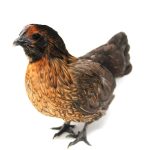When considering raising chickens, it is important to understand the diverse range of breeds available, each with distinct characteristics and traits. Popular breeds include Rhode Island Red, Plymouth Rock, Leghorn, and Sussex, which differ in size, color, egg production, and temperament. For instance, Rhode Island Reds are known for their high egg production and friendly nature, while Leghorns are valued for their prolific egg-laying and active behavior.
Understanding these differences is crucial when contemplating mixing chicken breeds. Climate and environmental factors also play a significant role in breed selection. Some breeds, like the Orpington, are well-adapted to cold climates, making them suitable for colder regions.
Conversely, Mediterranean breeds such as Leghorns thrive in warmer environments. Additionally, certain breeds are better suited for free-ranging, while others adapt well to confinement. Recognizing these unique characteristics and requirements is essential when deciding which breeds to combine in a flock.
Table of Contents
- 1 Benefits of Mixing Different Chicken Breeds
- 2 Considerations for Mixing Different Chicken Breeds
- 3 Challenges of Mixing Different Chicken Breeds
- 4 Tips for Successfully Mixing Different Chicken Breeds
- 5 Common Combinations of Mixed Chicken Breeds
- 6 Is Mixing Different Chicken Breeds Right for You?
- 7 FAQs
- 7.1 What happens when you mix different breeds of chickens?
- 7.2 Can you mix different breeds of chickens in the same flock?
- 7.3 What are the benefits of mixing different breeds of chickens?
- 7.4 Are there any drawbacks to mixing different breeds of chickens?
- 7.5 What are some popular breeds to mix together?
Key Takeaways
- Understanding Different Chicken Breeds
- There are many different chicken breeds, each with unique characteristics and traits.
- Different breeds have different egg-laying abilities, temperaments, and physical appearances.
- Benefits of Mixing Different Chicken Breeds
- Mixing different chicken breeds can lead to a more diverse and interesting flock.
- It can also result in a more productive and resilient flock, as different breeds may have different strengths and weaknesses.
- Considerations for Mixing Different Chicken Breeds
- It’s important to consider the space and resources needed to accommodate a mixed flock.
- Careful consideration should be given to the compatibility of different breeds in terms of temperament and behavior.
- Challenges of Mixing Different Chicken Breeds
- Managing different dietary needs and potential health issues can be challenging when mixing breeds.
- There may be social challenges within the flock as different breeds establish a pecking order.
- Tips for Successfully Mixing Different Chicken Breeds
- Introduce new birds to the flock gradually to minimize stress and aggression.
- Provide plenty of space, food, and water to accommodate the needs of different breeds.
- Common Combinations of Mixed Chicken Breeds
- Some popular combinations include mixing dual-purpose breeds with high egg-laying breeds for a balanced flock.
- Mixing ornamental breeds with productive breeds can create a visually appealing and functional flock.
- Conclusion: Is Mixing Different Chicken Breeds Right for You?
- Mixing different chicken breeds can be rewarding but requires careful planning and consideration of the unique needs of each breed.
- Ultimately, the decision to mix different chicken breeds depends on your specific goals and resources.
Benefits of Mixing Different Chicken Breeds
Genetic Diversity and Healthier Chickens
Mixing different chicken breeds can lead to genetic diversity, which is essential for healthier and more resilient chickens. By introducing a wider gene pool, you can reduce the risk of genetic disorders and improve overall flock health.
A Visually Appealing Flock
Another advantage of mixing breeds is the creation of a visually appealing flock. You can expect a diverse range of colors, patterns, and feather types, making your flock a joy to behold.
Increased Productivity and Harmony
Mixing breeds can also lead to increased productivity and a more harmonious social dynamic within the flock. By selecting breeds with complementary traits, such as high egg production or superior meat quality, you can create a more efficient and productive flock. Additionally, different breeds may have varying temperaments and pecking orders, reducing the likelihood of aggression and bullying.
Considerations for Mixing Different Chicken Breeds

While there are many benefits to mixing different chicken breeds, there are also several important considerations to keep in mind. One key consideration is the compatibility of the breeds you plan to mix. Some breeds are more aggressive or dominant, while others are more docile and submissive.
It’s important to research the temperament of each breed and consider how they may interact with one another in a mixed flock. Additionally, some breeds have specific space or housing requirements, so it’s essential to ensure that your coop and run are suitable for the breeds you plan to mix. Another consideration is the purpose of your flock.
Are you primarily interested in egg production, meat quality, or both? Understanding the specific traits and characteristics of each breed can help you select breeds that complement one another and align with your goals for your flock. Additionally, consider the climate and environment in which you live, as some breeds are better suited for specific conditions.
By carefully considering these factors, you can create a mixed flock that is well-suited to your needs and environment.
Challenges of Mixing Different Chicken Breeds
While mixing different chicken breeds can be beneficial, it also comes with its own set of challenges. One challenge is managing the varying dietary needs of different breeds. Some breeds may require a higher protein diet for optimal egg production or growth, while others may have specific nutritional requirements based on their size or activity level.
It’s important to carefully consider the dietary needs of each breed in your mixed flock and ensure that they are receiving the appropriate nutrition. Another challenge is managing the social dynamics within a mixed flock. Different breeds may have varying temperaments and pecking orders, which can lead to aggression and bullying within the flock.
It’s important to monitor the interactions between different breeds and intervene if necessary to prevent any aggressive behavior. Additionally, some breeds may be more prone to health issues or genetic disorders, so it’s important to be vigilant about monitoring the health of each breed in your mixed flock.
Tips for Successfully Mixing Different Chicken Breeds
To successfully mix different chicken breeds in your flock, there are several tips to keep in mind. First, provide ample space and resources for your mixed flock. This includes ensuring that your coop and run are large enough to accommodate the varying space requirements of different breeds, as well as providing multiple feeders and waterers to prevent competition and aggression at feeding time.
Secondly, carefully monitor the social dynamics within your mixed flock and intervene if necessary to prevent any aggressive behavior. This may involve separating certain individuals or providing additional resources to reduce competition. Additionally, providing plenty of enrichment and distractions can help reduce boredom and aggression within the flock.
Furthermore, it’s important to be proactive about monitoring the health of each breed in your mixed flock. This includes regular health checks, vaccinations as needed, and providing appropriate veterinary care when necessary. By staying vigilant about the health of your mixed flock, you can help prevent any potential issues from arising.
Common Combinations of Mixed Chicken Breeds

Dual-Purpose Breeds for Eggs and Meat
One popular combination is mixing dual-purpose breeds with high egg-laying breeds. For example, mixing Rhode Island Reds with Leghorns can result in a flock that provides both eggs and meat. This combination allows for a diverse range of egg colors and sizes while also ensuring a steady supply of eggs.
Climate-Resilient Breeds
Another common combination is mixing cold-hardy breeds with heat-tolerant breeds. For example, mixing Orpingtons with Sussex or Leghorns can create a flock that is well-suited for varying climate conditions. This combination allows for a more resilient flock that can thrive in different environments.
Visually Stunning Flocks
Additionally, mixing ornamental or exotic breeds with more common production breeds can result in a visually stunning and diverse flock. For example, mixing Polish or Silkie chickens with Rhode Island Reds or Plymouth Rocks can create a visually appealing flock with a wide range of colors and feather types.
Is Mixing Different Chicken Breeds Right for You?
In conclusion, mixing different chicken breeds can be a rewarding experience that offers several benefits, including genetic diversity, increased productivity, and a more harmonious social dynamic within the flock. However, it’s important to carefully consider the compatibility of the breeds you plan to mix, as well as their specific space, dietary, and environmental requirements. Additionally, it’s essential to be proactive about monitoring the health and social dynamics within a mixed flock to ensure a successful outcome.
Ultimately, whether mixing different chicken breeds is right for you depends on your specific goals and circumstances. If you’re interested in creating a diverse and productive flock that offers both eggs and meat, mixing different chicken breeds may be a great option for you. However, if you have limited space or resources or prefer a more uniform flock with specific traits, sticking to a single breed may be a better choice.
Regardless of your decision, it’s important to thoroughly research and understand the unique characteristics of each breed before making any decisions about mixing different chicken breeds in your flock.
If you’re interested in learning more about mixing different breeds of chickens, you may want to check out this article on The Chicken Coop Country Diner. This article discusses the benefits and challenges of mixing different breeds of chickens in a coop setting, and provides helpful tips for successfully integrating different breeds.
FAQs
What happens when you mix different breeds of chickens?
When you mix different breeds of chickens, you can create a hybrid chicken with a combination of traits from the parent breeds. This can result in chickens that have unique color patterns, egg-laying abilities, and temperaments.
Can you mix different breeds of chickens in the same flock?
Yes, you can mix different breeds of chickens in the same flock. However, it’s important to consider the size and temperament of the breeds to ensure they will get along well. It’s also important to provide enough space and resources for all the chickens in the flock.
What are the benefits of mixing different breeds of chickens?
Mixing different breeds of chickens can result in hybrid vigor, which can lead to healthier and more robust chickens. It can also create chickens with unique and desirable traits, such as better egg production, cold hardiness, or docile temperaments.
Are there any drawbacks to mixing different breeds of chickens?
One potential drawback of mixing different breeds of chickens is that the resulting hybrids may not consistently exhibit the desired traits of the parent breeds. Additionally, some hybrids may be less predictable in terms of behavior and egg production.
What are some popular breeds to mix together?
Some popular breeds to mix together include the Rhode Island Red, Plymouth Rock, and Leghorn. These breeds are known for their egg-laying abilities and can produce hybrid chickens with excellent productivity.
Meet Walter, the feathered-friend fanatic of Florida! Nestled in the sunshine state, Walter struts through life with his feathered companions, clucking his way to happiness. With a coop that’s fancier than a five-star hotel, he’s the Don Juan of the chicken world. When he’s not teaching his hens to do the cha-cha, you’ll find him in a heated debate with his prized rooster, Sir Clucks-a-Lot. Walter’s poultry passion is no yolk; he’s the sunny-side-up guy you never knew you needed in your flock of friends!







